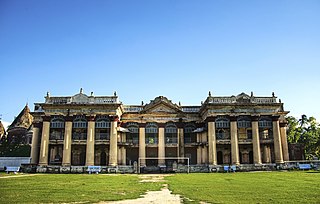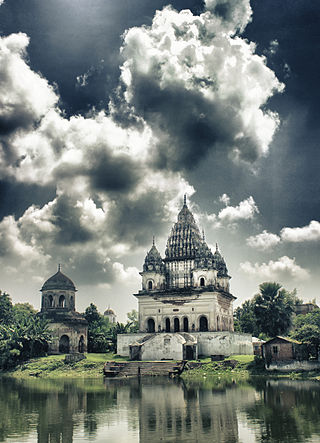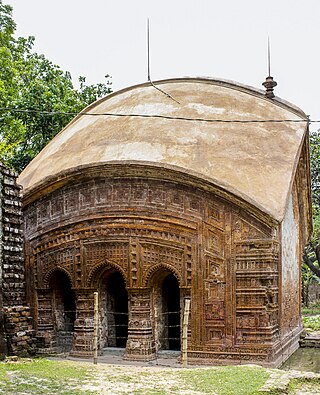
Rajshahi District is a district in mid-western Bangladesh. It is a part of the Rajshahi Division. The metropolitan city of Rajshahi is in Rajshahi District.

Puthia is an Upazila of Rajshahi District in the Division of Rajshahi, Bangladesh.

Tourism in Bangladesh includes tourism to World Heritage Sites, historical monuments, resorts, beaches, picnic spots, forests, tribal people, and wildlife of various species. Activities for tourists include angling, water skiing, river cruising, hiking, rowing, yachting, beachgoing and sea bathing.

The Puthia Temple Complex consists of a cluster of notable old Hindu temples in Puthia Upazila, Rajshahi District, Bangladesh. Located 23 km to the east of Rajshahi city, it has the largest number of historic temples in Bangladesh. The temples were built by Hindu Zamindars Rajas of the Puthia Raj family who were noted philanthropists of Rajshahi. The temples have been built in terracotta in a variety of styles combining the typical Jor-bangla architecture with other influences. The Rajbari or Palace of the Raja of Puthia and the Dol Mancha are part of the complex. The temples are laid out around a lake named Shyam Sagar and the complex is surrounded by a moat called Shiv Sagar.

Natore Rajbari was a royal palace in Natore, Bangladesh. It was the residence and seat of the Rajshahi Raj family of zamindars. The famous queen Rani Bhabani lived here and after the death of her husband, expanded both the estate and the palace.

Zamindars of Natore were influential aristocratic Bengali Zamindars, who owned large estates in what is today Natore District in Bangladesh .

Puthia Rajbari is a palace in Puthia Upazila, Rajshahi District in Bangladesh. It was built in 1895, by Maharani Hemanta Kumari Devi in the memory of her mother-in-law Maharani Saratsundari Devi, it is an example of Indo-Saracenic Revival architecture. The palace is sited on the Rajshahi Natore highway 30 km from the east of the town and one km south from Rajshahi Natore highway. Currently it houses a museum narrating the history of Puthia and its adjoining area.

The Pancha Ratna Govinda Temple in Puthia village, Rajshahi district in Bangladesh. The temple is a striking monument, which was built in the 19th century. It has the architectural feature of five ratnas or spires. It is located within the inner precincts of the Puthia Rajbari or palace.

Pancha Ratna Shiva Temple, also known as Bhubaneswar Shiva Mandir, is a Hindu temple of the Puthia Temple Complex in Puthia Upazila, Rajshahi Division, Bangladesh. It is the largest Shiva temple in Bangladesh. The shrine overlooks the Shiv Sagar to its left. The temple is well decorated in pancharatna architectural style and is located at the entrance of the Puthia Rajbari. Among the surviving Hindu temples, this shrine is said to be "an exceptional and more attractive for its architectural beauty" in Bangladesh.
Do-Chala Chhota Ahnik Mandir is a Hindu temple of the Puthia Temple Complex in Puthia Upazila, Rajshahi Division, Bangladesh. The temple faces east, in close proximity to the north-west corner of the residence of Maharani Hemanta Kumari. Believed to date to the 1790s-1800s period, it has a rectangular ground plan, with triple archways in the east and south. The east and south facades are "highly decorated with terracotta plaques depicting Radha-Krishna-Balram legends, the episode of Ramayana and floral motifs like the Bara Govinda Mandir. The roof cover is of do-chala type with curved cornice.

Bara Ahnik Mandir is a Hindu temple of the Puthia Temple Complex in Puthia Upazila, Rajshahi Division, Bangladesh. It stands next to Chauchala Chhota Govinda Mandir and faces east. It was built by the Rajas of Puthia. It follows a mixed form of Bengal temple architecture with a central Do Chala flanked with two Char Chala structures on both sides. The only other of known existence of something similar type in Bangladesh being Rajaram Mandir in Faridpur District.
Tarapur Mandir is a Hindu temple of the Puthia Temple Complex in Puthia Upazila, Rajshahi Division, Bangladesh. Its construction is dated to the 18th century. It is also known by other names as Rath Bagicha Tarapur and Hawakhana among the local residents.

Dol-Mandir, also known as Dol-Mandav is a Hindu temple of the Puthia Temple Complex in Puthia Upazila, Rajshahi Division, Bangladesh. It is located within the Puthia market area. An inscription dates the temple to 1778 built by Vubanendra Narayan, the Panch Ani Raja.
Chhota Shiva Mandir is a Hindu temple of the Puthia Temple Complex in Puthia Upazila, Rajshahi Division, Bangladesh. The temple, built in 1804, is credited to the Raja Anandanarayan of the Chauddapai.
Gopal Mandir also called as Dwarkadhish temple is the second largest temple of Ujjain after Mahakaleshwar and is dedicated to Lord Krishna, in Ujjain City, Ujjain Division, Madhya Pradesh, India. It was built by Bayaji bai Shinde, the wife of Maratha King Daulatrao Scindia in the 19th century in Maratha Style. It is located in the main market of Ujjain.

Chota Anhik Mandir is a Hindu temple of the Puthia Temple Complex in Puthia Upazila, Rajshahi Division, Bangladesh.
Baranagar is a village in the Murshidabad-Jiaganj CD block in the Lalbag subdivision of Murshidabad district in the state of West Bengal, India.
















